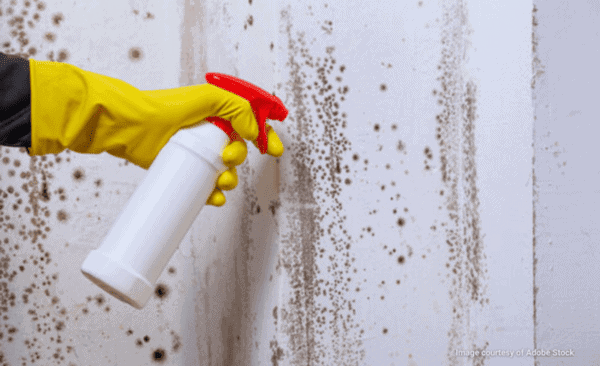Most people worry about mold sometimes, but not everyone realizes it can often appear in the laundry room! Whether you were already aware of the danger of mold in the laundry room, or you’re just thinking about it for the first time, this is the article for you. We’re going to cover what it is, how to prevent it, what does and doesn’t work to clean it, and much more!
Why should you trust our information? Glad you asked. We’re Cleaner Guys, a professional mold removal company with more than 20 years of experience. It’s our job to know everything there is to know about mold, and we want to share it with everyone, so you’re prepared to deal with mold if it ever comes your way! Read on.
Table of Contents
- What Causes Mold in the Laundry Room?
- Is Mold in a Laundry Room Dangerous?
- How Do You Clean Mold in a Laundry Room?
- How Do You Prevent Mold in a Laundry Room?
- Can Mold in a Washing Machine Ruin Clothes?
- Key Takeaways
- More Resources
What Causes Mold in the Laundry Room?
Mold spores are in the air all the time, like dust and bacteria; but they will only land and sprout into mold growth where there is excess moisture. Mold needs moisture, organic material to feed on, and warmth to grow. It can absorb drywall, wood, and textiles for food, which is why it is most commonly found on walls, ceilings, carpet, and wood like framing and baseboard trim.
Mold is common in laundry rooms because the washing machine regularly contains a lot of water. If there is any leak in the machine, it can cause mold growth. Water and moist clothing sitting in the machine can also cause mold growth over time. But never fear! We’ll cover prevention in this article too.
Is Mold in a Laundry Room Dangerous?
Mold in laundry rooms is usually not dangerous, but it can be, so you should be very careful. Most species of molds are allergenic, which means they can cause mold sickness symptoms similar to allergies or a cold. But there is a species of mold that is extremely toxic. Prolonged exposure to the mycotoxins released by Stachybotrys Chartarum — a species of black mold — can cause nausea, nose bleeds, internal hemorrhaging, lung damage, and even neurological problems.
Thankfully, this species of highly dangerous mold is not very common. However, it looks basically like every other species of allergenic black and dark green mold, so caution is strongly advised when dealing with any species of black mold. You don’t know if it’s the dangerous kind or not.
How Do You Clean Mold in a Laundry Room?
The best way to clean a small patch of mold (under 1 square foot) is with a fungicide detergent. We recommend Fiberlock Shockwave. Cleaner Guys is not affiliated with Fiberlock in any way. We just use and love their product.
If the mold covers more than 1 square foot, or there are several small patches in an area, then the best way to get rid of the mold growth is complete removal of the infested materials. This should only be done by professional mold removers, because they have the training, knowledge, and equipment to remove the mold safely and effectively.
Many unprofessional publications on the internet, including home decor magazines, forums, “health” publications, and even maid services, say that you can use vinegar and bleach to kill mold. However, in our decades of professional experience dealing with mold, we do not find these methods to be effective most of the time. Here’s why.
Vinegar and Mold
We do not recommend trying vinegar on anything but the smallest patch of mold — under 1 square foot. This is because vinegar can kill mold, but it does not penetrate deeply into any material it is applied to. Mold roots very deeply into materials like drywall and wood, so while cleaning the surface of these materials may appear to kill the mold, there is most likely still mold rooted deep in the material that the vinegar could not reach.
Vinegar can be used to clean molds that grow only on the surface, such as the mildew you find in showers, and on plastic and tile.
Bleach and Mold
We do not recommend ever using bleach on mold of any size. It’s fumes are unhealthy, it usually severely damages surfaces it is applied to, and it does not penetrate deeply enough — just like vinegar. Bleach is both too strong for regular cleaning, and at the same time, ineffective against mold growing in drywall and wood.
We have also written articles on using rubbing alcohol, dish soap, and Clorox wipes on mold. Read these if you want more information on household cleaning chemicals and mold.

How Do You Prevent Mold in a Laundry Room?
There are several things you can do to prevent mold in a laundry room! They mostly involve making sure there is no excess moisture either leaking out of the washing machine or sitting inside of it. Follow these directions regularly, and you should successfully avoid mold in your laundry room.
- Pull the washing machine away from the wall at least once a month, to check for any leaks and look for mold.
- Clean all the crevices of the rubber gasket of the washing machine at least once a month, with cleaning wipes or household cleaner and a cleaning cloth.
- Spray and wipe down the drum of the washing machine with a regular disinfectant every few months.
- Create ventilation to avoid high humidity. Open a window nearby while the washer is running, or install a ceiling exhaust fan for extra ventilation.
- Clean the laundry room regularly; mold can feed on dirt and food particles!
Can Mold in a Washing Machine Ruin Clothes?
If you run your clothes through your washing machine, and then discover that it had mold in it, don’t panic. Your clothes aren’t ruined! There are steps you can take to remove the mold from them. One of our resident mold experts, Bob, gives specific advice for cleaning clothing with mold on them. “For washing moldy items, I find that DSV works really great. Running the items through a wash cycle with DSV and then again with normal detergent is a good play.”
We are not affiliated with DSV in any way; this is simply what our mold experts do when they get mold on their clothes.
Key Takeaways
There are several simple habitual things you can do to prevent mold in your laundry room, including increasing ventilation, checking thoroughly behind the washer for water leaks and mold on a regular basis, and cleaning the inside of the washer regularly. If you do get mold in your laundry room, you can try cleaning it with fungicide or vinegar if it is a very small patch. However, if it is a large area, you should leave its removal to a professional mold removal company. Most molds are not dangerous, but one species is, so you should treat all black and dark green mold carefully, because you don’t know if it’s the dangerous kind.
More Resources
Need more specific help with your mold issues? Check out some of our most popular articles below.
The top 10 causes of mold in an apartment ➜
What will happen if you touch mold with your bare hands? ➜
Signs there is mold inside your walls ➜
If you find yourself in the unfortunate position of needing a mold removal company in Western Washington State, consider Cleaner Guys as a high-quality, well-trusted option. We’re proud to boast award-winning customer service, lower prices than others, and top-notch workmanship! Contact us today through the menu at the top of your screen.

Disclaimer: This article is for informational purposes only. No part of this article is medical or legal advice, and may not be used as such. For all serious medical matters, consult your doctor. For all serious legal matters, consult your legal advisor. This article contains Cleaner Guys’ experience and opinions only.


